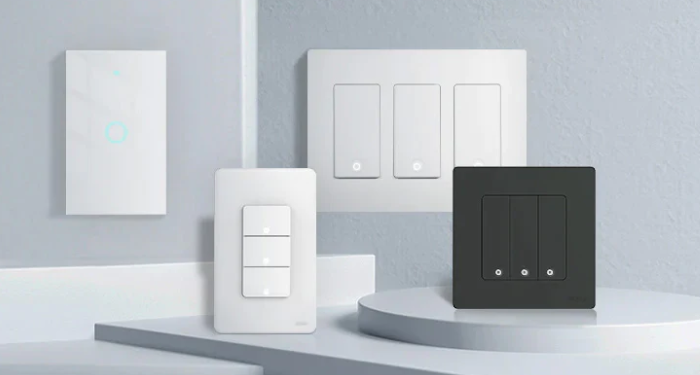Traditional switches generally refer to mechanical switches, and the representative product is the wall switch. There are no shortcomings in the actual application of wall switches and smart switches in single control. If we talk about the shortcomings of wall switches compared to smart switches, they are mainly reflected in the realization of multi-link interactive control. This kind of effect and function at the multi-link interactive application level is difficult to achieve with traditional mechanical switches.
To understand why smart switches can achieve multi-link interactive control, first let's take a look at the structures of traditional switches and smart switches.
traditional switch
You can see that this is a very simple circuit, which is about the knowledge of junior high school physics. The lamp is connected to the neutral wire and the live wire of the alternating current respectively, and then a mechanical switch controls the opening and closing of the live wire, thereby controlling the opening and closing of the lamp.
Smart switch
Compared with traditional switches, smart switches use relays and intelligent modules to replace the original mechanical switches, and the opening and closing of the lights are controlled by relays. The opening and closing of a circuit by a relay is no different from a mechanical switch, but in order for the smart switch to have power, we need to connect a neutral wire. This kind of smart switch is called zero fire smart switch.
However, not all households are willing to use open wires to pull an unsightly neutral wire to the switch, so with the development of technology, single-fire smart switches have emerged. If the zero-fire version of the smart switch is connected in parallel to the circuit like other large and small appliances in the home, then the single-fire version of the smart switch is connected in series to the lamp: But such a single-fire switch has a very big disadvantage , that is, even when the relay is disconnected, the current flowing through the smart module will also pass through the lamp to form a loop. Of course, when the current is small enough and the power of the lamp is large enough, you will not notice any problems. . But when the power of the smart module is slightly higher, or you use a very low-power LED light, problems will arise - the light will start to flash. In order to solve this problem, it was later developed to add a capacitor at both ends of the lamp to allow the current to pass through the capacitor as much as possible: OK, now we have a basic understanding of the structure of traditional switches and smart switches. Of course, these are just rough sketches and the actual structure is much more complex than these. We can find that no matter which wiring method is used, smart switches have one more component called "smart module" than traditional switches.
This smart module can contain a lot of things. It includes hardware, dimming modules, voice modules, etc. that communicate with smart hosts. Different modules are set up according to different application scenarios to achieve different functions and multi-link interactive control between each other.
At present, compared with traditional switches, the functions that smart switches can achieve are: 1. Centralized control to turn off the device with one click when going out, or when guests come at home, you can start the reception or entertainment lighting scene with one click without having to Go all the way and press the switch all the time.
- Remote control is also the main function of all smart home appliances currently. It is to control the device on and off through the mobile phone app. This is also the basic part of the so-called "smart". You can turn the lights on and off wherever you need at any location at home, which is especially practical for the elderly, pregnant women, and children. The room is air-conditioned for children, which is convenient and worry-free.
- Timing control: According to different times and events, the device can be set to automatically turn on or off. 4. Whole-house control Every electrical appliance you can think of in the home, even the curtains, can be controlled with smart switches, including electric fans, air purifiers, water dispensers, air conditioners, etc.
It can upgrade your home's traditional switches, dimmer switches, curtain switches, and dual-control switches to wireless smart switches, which can be controlled remotely through the mobile APP while retaining the physical touch of the switch.
The most important thing is that there is no need to install an independent gateway, which saves a lot of hidden costs and increases the convenience of operation. The installation of the product is exactly the same as a normal switch socket, without adding additional wires. The brightness of all lights can be set at will according to preference, and different atmospheres can be created through different combinations of lights. The function of turning off all switches with one click at night cannot be more considerate. In the morning, you can also use the light wake-up function. Imagine that the curtains automatically open at a fixed time every day, and the light in the room slowly and softly brightens like the sunrise, allowing you to wake up naturally... how wonderful this would be. There is no doubt that smart switches have broad development and prospects in the smart home industry. It is an unchangeable fact that ordinary switches will gradually be eliminated by the market. With the slow development of the smart home industry, smart switches will need to go through a buffer period until they are fully accepted by the market. It will become more and more powerful in the smart home industry.
